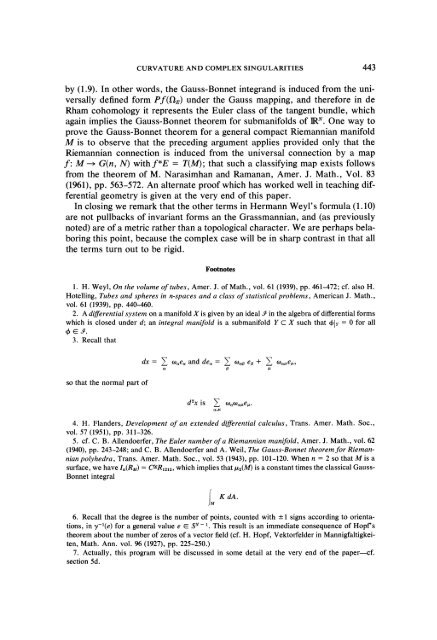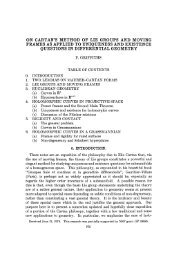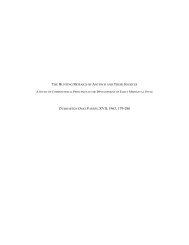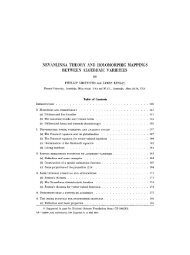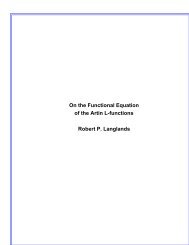View PDF - Project Euclid
View PDF - Project Euclid
View PDF - Project Euclid
You also want an ePaper? Increase the reach of your titles
YUMPU automatically turns print PDFs into web optimized ePapers that Google loves.
CURVATURE AND COMPLEX SINGULARITIES 443<br />
by (1.9). In other words, the Gauss-Bonnet integrand is induced from the universally<br />
defined form Pf(I) under the Gauss mapping, and therefore in de<br />
Rham cohomology it represents the Euler class of the tangent bundle, which<br />
again implies the Gauss-Bonnet theorem for submanifolds of IR. One way to<br />
prove the Gauss-Bonnet theorem for a general compact Riemannian manifold<br />
M is to observe that the preceding argument applies provided only that the<br />
Riemannian connection is induced from the universal connection by a map<br />
f: M G(n, N) with f*E T(M); that such a classifying map exists follows<br />
from the theorem of M. Narasimhan and Ramanan, Amer. J. Math., Vol. 83<br />
(1961), pp. 563-572. An alternate proof which has worked well in teaching differential<br />
geometry is given at the very end of this paper.<br />
In closing we remark that the other terms in Hermann Weyl’s formula (1.10)<br />
are not pullbacks of invariant forms an the Grassmannian, and (as previously<br />
noted) are of a metric rather than a topological character. We are perhaps belaboring<br />
this point, because the complex case will be in sharp contrast in that all<br />
the terms turn out to be rigid.<br />
Footnotes<br />
1. H. Weyl, On the volume of tubes, Amer. J. of Math., vol. 61 (1939), pp. 461-472; cf. also H.<br />
Hotelling, Tubes and spheres in n-spaces and a class of statistical problems, American J. Math.,<br />
vol. 61 (1939), pp. 440-460.<br />
2. A differential system on a manifold X is given by an ideal in the algebra of differential forms<br />
which is closed under d; an integral manifold is a submanifold Y C X such that b[y 0 for all<br />
3. Recall that<br />
so that the normal part of<br />
dx 2 toeandde= Z to13 e13 + Z oo,e,,<br />
d2x is<br />
4. H. Flanders, Development of an extended differential calculus, Trans. Amer. Math. Soc.,<br />
vol. 57 (1951), pp. 311-326.<br />
5. cf. C. B. Allendoerfer, The Euler number ofa Riemannian manifold, Amer. J. Math., vol. 62<br />
(1940), pp. 243-248; and C. B. Allendoerfer and A. Weil, The Gauss-Bonnet theorem for Riemannian<br />
polyhedra, Trans. Amer. Math. Soc., vol. 53 (1943), pp. 101-120. When n 2 so that M is a<br />
surface, we have In(RM) CeR1212, which implies that/z2(M) is a constant times the classical Gauss-<br />
Bonnet integral<br />
6. Recall that the degree is the number of points, counted with --. signs according to orientations,<br />
in y-l(e) for a general value e S s- 1. This result is an immediate consequence of Hopf’s<br />
theorem about the number of zeros of a vector field (cf. H. Hopf, Vektorfelder in Mannigfaltigkeiten,<br />
Math. Ann. vol. 96 (1927), pp. 225-250.)<br />
7. Actually, this program will be discussed in some detail at the very end of the paper---cf.<br />
section 5d.


